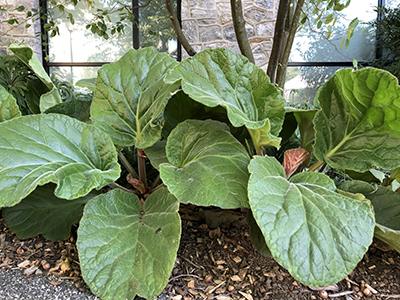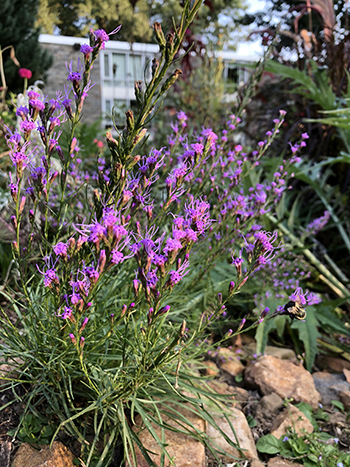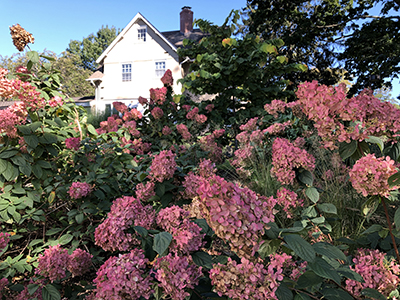
Plant of the Week: September 28

Bergenia is one of those plants you love showing to garden visitors. My first introduction to the genus was with Bergenia cordifolia. Commonly known as pigsqueak, the fleshy, cabbage-like leaves emit a squeaky noise when rubbed. Using your thumb and index finger, gently make a rubbing motion back and forth across the leaf surface as if trying to remove Elmer’s glue from your fingers after a crafting project.
Hailing from the Himalayas, Bergenia ciliata ‘Wilton’ (hairy bergenia) is the fuzzy cousin of B. cordifolia. The large, finely-haired leaves are a highlight, especially when coated with a fine dew. For best results grow in partial shade to avoid leaf scorch, and encourage the leaves to grow as large as possible by mulching annually with an aged compost. Bergenia ciliata ‘Wilton’ is planted along the north side of Kohlberg Hall. Photo credit: J. Coceano

Liatris microcephala (Appalachian blazing star; dwarf blazing star) is found throughout the Southern Appalachian Mountain range on lean, dry soils. While small in stature, individual plants produce multiple upright flowering stalks, each bearing a multitude of small, rosy-purple flower heads. Each flower head is composed of 4 – 6 disc-shaped florets. Plants must have dry, lean soils to thrive. In the landscape L. microcephala is a good choice for rock gardens, pollinator gardens, or water-wise plantings. A planting is found on a slope in the Cut Flower Garden. Photo credit: J. Coceano

Hydrangea paniculata ‘SMHPFL’ (Fire Light® panicle hydrangea) creates a dramatic pop of color in the garden. Blooms emerge creamy white then transition quickly to red and pink hues. I’ve noticed that my perception of their color varies according to the intensity of the sunlight. The blooms have a fuschia pink tone on cloudy days, only to look more rusty red in the bright sunlight. While there are numerous cultivars of panicle hydrangea to choose from, this one is a stand-out with its two distinct floral displays. A group planting is found along Whittier Hall. Photo credit: J. Coceano





No Comments